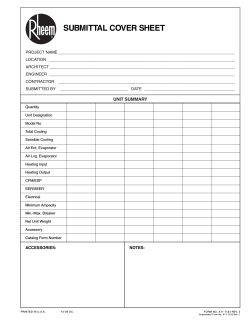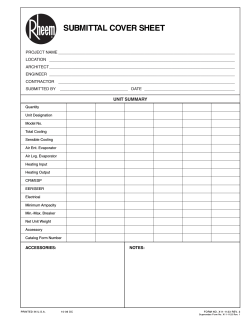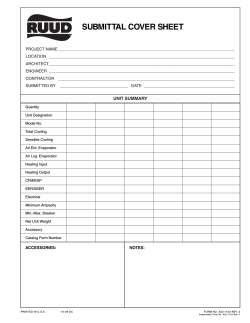
H T C R
HOW TO CHOOSE THE RIGHT AQUECOIL™ HWC DUCT COIL Bindus Manufacturing, LLC currently offers three different series of duct coils in the HWC family. To keep things simple, they are the A-Series, B-Series, and C-Series. All units have copper waterways and are suitable for use with boilers as well as conventional or tankless potable hot water heaters. The aluminum fins are mechanically bonded to the copper water tubes to maximize heat transfer. A-Series This series is the most common style of duct coil in use today. It uses 1/2” inch waterways and is stocked in a number of common sizes. All units have a steel flange that extends 1” from the finned area creating a frame around the coil. You can choose whether you want a 2-row or 3-row heat exchanger without affecting the unit thickness. Installation usually consists of cutting the ductwork completely open and creating a flange to attach to the steel flange of the hydronic coil. The installer then insulates the exposed sides and ends of the coil. B-Series This series is less commonly found in the field. It uses 3/8” inch waterways and is stocked in three sizes. There is a steel flange protecting the u-bends and an aluminum plate that runs along the fins on the other edges. It is available in 2-row configurations only. A factory installed bleed port is included. This series comes with flanges already attached and ready to insert into the duct sections. Installation consists of cutting a slot into the ductwork on one or more sides and then sliding the coil into the newly created slot. The installer insulates the ductwork as required. C-Series This series is rapidly gaining in popularity. It uses 3/8” inch waterways and is stocked in three sizes. A fully insulated, aluminum cabinet encloses the coil. It is available in 2-row configurations only. A factory installed bleed port is included. The HWC C-Series has openings similar to the discharge opening of air handlers. The flange measures 1” to allow for easy connection to ductwork. Installation consists of attaching the ductwork to both sides of the HWC using the cabinet’s flanges. There is no need to add additional insulation to the coil. Please refer to the appropriate specification sheet for performance data and sizes. Contact the manufacturer directly with any questions via phone, fax or through the website. !5%6+7#89:;<#==3>?3@3# AB&7# ##89:;<#==3>?;4;# CCCDEFGH2"IJD2")! !"#$%&#'((# )%%*+,-.//+0#12#34''(#
© Copyright 2025





















